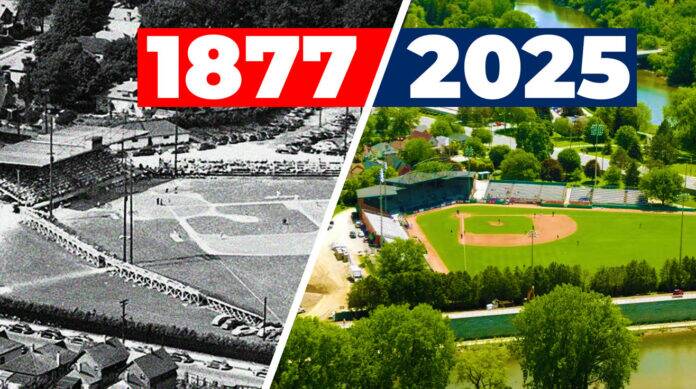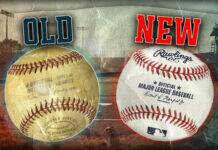
Step into a world where history echoes within stadium walls. These ballparks aren’t just playing fields; they’re monuments to America’s pastime. Spanning five decades from 1874 to 1926, each venue preserves unique stories of notable players and cultural significance. These parks replay the soundtrack of baseball’s evolution across generations.
Palmar de Junco Stadium
This park hosted the first official Cuban baseball game in December 1874. Considered the cradle of Cuban baseball, it shaped the sport’s early development across the island and previously housed the Cuban Baseball Hall of Fame.
No Cuban National Series teams currently play there. Baseball historians recognize it as one of the oldest continually operating baseball venues in the world, making it a cultural landmark that draws enthusiasts globally.
Labatt Memorial Park
Built in 1877 as Tecumseh Park in London, Ontario, this site earned recognition from Guinness World Records as the world’s oldest continuously operating baseball grounds. A devastating flood forced officials to shift the diamond in 1883, demonstrating the venue’s resilience.
The London Majors have called it home since 1925. Its center field dimension extends to 402 feet, with 5,200 seats available. Similar to a treasured family heirloom, this park has weathered storms and changes while maintaining its essential character for nearly 150 years.
Fuller Field
Baseball history takes physical form at this Clinton, Massachusetts field built in 1878. Guinness World Records certifies it as baseball’s oldest continuous diamond in the United States. Initially named Clinton Baseball Ground, it once showcased Hall of Fame pitcher Tim Keefe’s remarkable skills.
Youth and adult teams continue to play on the same ground where baseball pioneers competed. The field serves history much as a vintage instrument produces tones impossible to replicate with modern manufacturing – authentic, rich, and connected to something larger than itself.
League Stadium
Built in 1894 in Huntingburg, Indiana, this park draws history buffs and film enthusiasts alike. The Dubois County Dragons played here throughout the 1990s. Today it serves as home to the Dubois County Bombers summer collegiate team.
Hollywood transformed the park in 1991 during renovations for “A League of Their Own.” With a center field wall sitting 385 feet from home plate and seating for 2,783 fans, the stadium offers visitors an authentic glimpse into baseball’s golden age. (Yes, that means you can literally sit where Tom Hanks shouted “There’s no crying in baseball!”)
Drayton McLane Baseball Stadium at John H. Jacobs Field
Michigan State University’s baseball tradition lives within this East Lansing stadium, which began as Old College Field in 1902. The venue gained the Jacobs name in 1969 before adding McLane’s name in 2008 following significant renovations.
The outfield wall displays honored numbers of notable Spartan alumni including Kirk Gibson, Steve Garvey, and Robin Roberts. Center field stands 400 feet from home plate, with seating for 4,000 fans. Similar to ingredients in a signature recipe, each renovation has added complexity while preserving the essential character of this historic collegiate venue.
Hanover Insurance Park at Fitton Field
New England preserves some of baseball’s most cherished sites, including this Worcester, Massachusetts landmark. Initially hosting Holy Cross football as early as 1903, baseball followed in 1905 and has remained ever since.
The field has witnessed baseball royalty, as Lou Gehrig played here in 1922 with Columbia University. Babe Ruth appeared in a 1935 exhibition game. Known simply as Fitton Field for over a century, corporate sponsorship brought a name change while preserving its historical character. The Worcester Bravehearts have played here since 2014.
Centennial Field
Vermont’s historic baseball park was dedicated in 1904 on land celebrating the university’s 100th anniversary. The first game was played in 1906. The University of Vermont fielded teams here until 2009, and the Vermont Lake Monsters have played here since 1994.
Natural grass covers the playing surface, maintaining traditional baseball aesthetics rarely found in modern parks. The outfield extends 405 feet to dead center. This park resembles an old video game that everyone still loves to play – it might lack modern graphics, but the gameplay remains perfectly tuned for 4,415 spectators who can witness games from its vintage grandstand.
Goss Stadium at Coleman Field
Oregon State University’s baseball program began on April 12, 1907, with the first pitch at what would become one of college baseball’s most storied venues. The Beavers have called it home continuously since that day, making it the oldest continuously used baseball field in the NCAA’s Pac-12 Conference.
Recent renovations replaced natural grass with artificial turf to accommodate the Pacific Northwest’s rainy climate. (Because nothing says “play ball” quite as pathetically as squishing around in Oregon mud.) The outfield measures 400 feet to center, with seating for 3,587 fans. Situated 240 feet above sea level, the park offers a unique setting for college baseball in the Willamette Valley.
Horlick Field
Racine’s historic ballpark opened in 1907 after William Horlick donated the land and funds for construction. It initially hosted the Racine Malted Milks minor league team, named after Horlick’s malted milk product that gained international popularity.
From 1943 to 1950, the Racine Belles of the All-American Girls Professional Baseball League played here. The Chicago American Giants of the Negro National League also played some games here in 1945. Distinctive stone walls surround the entire complex, accommodating approximately 5,000 fans within its historic confines.
Cardines Field
Newport, Rhode Island’s legendary ballpark originated when local railroaders built their own baseball diamond around 1908. Initially known as Basin Field due to its location, the park developed a rich history hosting barnstorming Negro League All-Stars, including games featuring pitching legend Satchel Paige.
During World War II, navy personnel stationed in Newport created remarkable exhibition games featuring MLB stars who were serving in the military. Today, the Newport Gulls collegiate summer team plays here. Comparable to wilderness trails that reveal new wonders with each visit, this park continually unveils layers of history just when you think you’ve seen it all.
Warren Ballpark
Mining companies in early 20th century Arizona built more than just industrial facilities. In 1909, the Calumet and Arizona Mining Company constructed Warren Ballpark in Bisbee to boost community morale and provide entertainment for workers. The field turned professional in 1947.
The Copper Kings played there until 1958, with a brief return in 2003. Today, high school baseball and football teams use this historic field. It stands as one of the oldest continuously operating multi-sport stadiums in America and represents an important connection between industrial and sporting heritage.
Rickwood Field
Built in 1910 in Birmingham, Alabama, this park stands as the oldest professional baseball stadium in the United States. Once home to both the Birmingham Barons and Birmingham Black Barons, the stadium preserves a crucial era in baseball’s segregated history.
Visitors can sit in the same grandstand where a young Willie Mays displayed his remarkable talents. Hollywood filmmakers have used the setting for baseball movies including “42” and “Cobb.” Major League Baseball has scheduled a regular season game between the Giants and Cardinals here on June 20, 2025. (Mark your calendars now – tickets will vanish faster than free food at an office party.)
Fenway Park
Boston’s iconic ballpark opened its gates in 1912 and has remained home to the Red Sox ever since. While Wrigley Field embraced ivy-covered brick walls, Fenway’s architects created the now-iconic Green Monster—a 37-foot left field wall that transformed how the game is played in Boston.
The Boston Braves and various football teams also used Fenway from the 1920s through the 1960s. The center field dimensions have varied through numerous renovations, typically measuring around 390 feet. Modern expansion has increased seating capacity to over 37,000 fans. Akin to a first date that turns into a lifelong romance, your first visit to Fenway creates an unforgettable experience that keeps fans returning for generations.
Jackie Robinson Ballpark
This park opened in 1914 as City Island Ballpark in Daytona Beach, Florida. When Robinson stepped onto this field in 1946, he wasn’t just playing a spring training game—he was beginning the dismantling of baseball’s color barrier in the still-segregated South.
Four major league teams used the facility for spring training throughout its history. The Daytona Tortugas have played here since 2015. A bronze statue of Robinson stands at the entrance, while the stadium’s museum chronicles this pivotal moment in civil rights history. The outfield spans 400 feet to center, with natural grass covering the playing field.
Wrigley Field
Chicago’s beloved North Side ballpark opened in 1914 as Wegman Park when chewing gum magnate William Wrigley Jr. wasn’t yet involved with the team. The Chicago Whales played here initially before the Cubs moved from the West Side Grounds in 1916.
After brief periods as Cubs Park and Cubs Field, it became Wrigley Field in 1927. The iconic park accommodates 41,600 fans today and features distinctive elements including the hand-operated scoreboard and ivy-covered outfield walls added in 1937. The surrounding Wrigleyville neighborhood creates a uniquely integrated urban ballpark experience. It’s baseball’s ultimate ecosystem – stadium and surroundings evolving together naturally.
Bosse Field
Indiana’s baseball history runs exceptionally deep, with Evansville’s Bosse Field opening in 1915 as the first municipally owned stadium in the United States. Located on Don Mattingly Way, its symbolic connection to one of the city’s greatest baseball sons adds prestige.
The Evansville Otters have played here since 1995, making it the third-oldest ballpark still regularly hosting professional baseball. The natural grass field stretches 415 feet to center. With seating for 5,181, the stadium maintains its historical character while serving modern fans. Much in the way “The Godfather” stands as both critically acclaimed art and popular entertainment, Bosse Field balances historical importance with everyday enjoyment.
Chiayi City Municipal Baseball Stadium
Taiwan’s baseball tradition began during Japanese colonial rule, with this historic stadium built in 1918 in Chiayi City. The venue represents baseball’s global spread through colonial influence, as Japanese administrators introduced the sport that would later become Taiwan’s national pastime.
From 1998 to 2003, the China Trust Whales of the Chinese Professional Baseball League played here. The seating accommodates 10,000 spectators, making it a significant cultural landmark in Taiwanese baseball history. It illustrates how baseball became a vehicle for national identity in post-colonial Taiwan.
Doubleday Field
Cooperstown, New York’s legendary field embraces its connection to baseball mythology, constructed on an old farm in 1920 near what would later become the National Baseball Hall of Fame and Museum. Though historical research has debunked the Abner Doubleday creation myth, the field celebrates baseball’s spiritual home.
Grandstands added in 1924 expanded its capacity. Today the venue seats 9,791 spectators with a center field distance of 390 feet. From 1940 to 2008, MLB’s Hall of Fame Game was played here annually during induction weekend. Comparable to a campfire story that everyone knows isn’t entirely true but enjoys anyway, Doubleday Field mixes myth and reality into something more meaningful than either could be alone.
Cramton Bowl
Montgomery, Alabama’s multi-sport facility was built atop a former landfill, opening in May 1922. Auburn and Vanderbilt played the first collegiate baseball game here. The Philadelphia Athletics later held spring training at the venue, connecting it to Connie Mack’s legendary team.
Various minor league and Negro League teams played here through the 1940s, including the 1943 Negro League World Series. Since the 1950s, the stadium has hosted football exclusively, transitioning away from its baseball origins while maintaining historical significance for both sports in the Deep South.
Robertson Field at Satow Stadium
Columbia University’s New York City ballpark opened in 1923, providing baseball in Manhattan’s dense urban environment. The intimate venue holds just 1,500 spectators, making it among the smallest collegiate facilities at a major university.
Artificial turf replaced natural grass in 2007 to improve drainage and reduce maintenance. Its center field fence sits unusually close to home plate due to space constraints, creating a unique playing environment that favors hitters. The stadium exemplifies how baseball adapted to limited urban spaces, similar to how New Yorkers maximize tiny apartments with creative solutions.
LECOM Park
Bradenton, Florida’s historic spring training facility opened in 1923 with just 2,000 seats. Renovations expanded its seating to 8,500 while preserving its old-Florida charm. The Pittsburgh Pirates have held spring training here since 1969, creating one of baseball’s longest continuous team-venue relationships.
During the regular season, the Bradenton Marauders play here, ensuring year-round baseball. The outfield measures 400 feet to center. Similar to how a great tailor knows when to update a classic suit and when to leave timeless elements alone, this park balances necessary modernization with respect for its historic appeal that draws fans year after year.
Ray Fisher Stadium
The University of Michigan’s baseball venue welcomed its first fans on April 21, 1923. Initially named Ferry Field for the entire athletic complex, it later honored Ray Fisher, the legendary coach who led Michigan baseball for 38 years.
The university has played all its home games here for a century, creating a continuous tradition rare in collegiate athletics. The stadium seats 4,000 spectators and features artificial turf, allowing earlier spring play in Michigan’s challenging climate. (Because nothing says “baseball season” quite as authentically as players shoveling snow off the field in April.) Its dimensions and facilities have evolved with collegiate baseball, representing the growth of university athletics.
Koshien Stadium
Japan’s most revered baseball venue opened on August 1, 1924, in Nishinomiya. Initially built to host the annual National High School Baseball Championship, the stadium embedded baseball within Japan’s educational tradition. The Hanshin Tigers professional team has played here since 1936.
Its original capacity reached 55,000 spectators, though renovations have reduced this to 47,000 today. Center field spans 387 feet from home plate. American baseball legends including Babe Ruth played exhibition games here during their 1934 tour. The park’s famous dirt infield—with soil so revered that high school players often collect it as souvenirs—exemplifies the spiritual connection Japanese fans have with their baseball traditions.
McCormick Field
Asheville, North Carolina’s historic ballpark opened in 1924 and ranks among the oldest continuously operating minor league venues in America. The Asheville Tourists have made it their home for generations, while the Asheville Blues of the Negro Southern League played here during the 1940s.
Racing enthusiasts might be surprised to learn that a track once circled the field during NASCAR’s early history. The stadium gained Hollywood recognition when it appeared in “Bull Durham.” Its distinctive outfield fence reaches a towering 36 feet high, rivaling Fenway’s Green Monster and creating a unique challenge for outfielders tracking fly balls against the imposing wall.
Meiji Jingu Stadium
Tokyo’s historic ballpark opened in 1926 after just 10 months of construction, built for the surprisingly modest sum of $4,000. The economic efficiency of its design contrasts sharply with today’s billion-dollar stadiums. With a capacity exceeding 30,000 fans, it has witnessed some of Japanese baseball’s most significant moments.
American legends including Babe Ruth played exhibition games here. The Tokyo Yakult Swallows have called it home since 1964. Though plans call for a new stadium to replace it by 2036, its century of service represents baseball’s enduring presence in Japanese culture, comparable to how certain movies become classics—creating a legacy that transcends their original era and continues to resonate with new generations.


